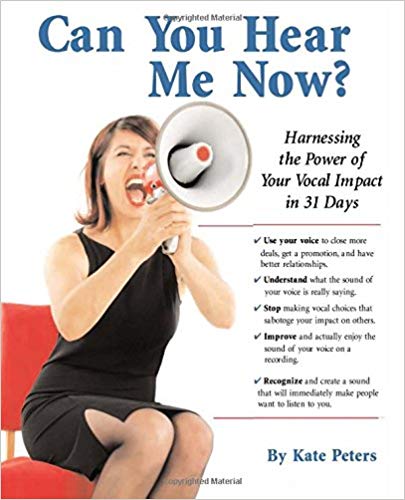How to Create a Strong Voice, Part 4: Practice
Since I still practice the old-fashioned way, in a room or in my car going over and over what’s in my head … or in the shower … it hadn’t occurred to me that there were apps out there that could help someone practice delivery/performance skills until I received a note from a reader via the contact form on my blog. He asked:
“Could you recommend an app or know of one that I could use to practice my speech cadence, pitch, and pace in the car on my daily commute? I drive over 2 hours a day and I’m looking to utilize that time to improve my skills in public speaking.”
I took the challenge and went searching online, and, what do you know? I found some good ones. I have to admit to being a little concerned that the apps might replace coaches such as myself (should I publish this stuff???) but after careful consideration, I learned that there are vocal apps that are great tools for vocal warm-ups and breathing exercises and even for focusing on intention; the best apps involve a little behavioral feedback as well, which is really helpful since most of us don’t have a coach there every minute to keep us in line. However, apps don’t replace speaking or singing aloud in an empty room. They enhance it.
In the following post, I talk about the benefits of practicing, how to approach practicing in general, and how to use tools of any kind to improve your skills development and performance.
You play like you practice.
Why practice? I can’t even believe I have to address this question, but I am always surprised at how many people tell me they think they are better just winging a presentation or performance. And to some, practicing is like pulling teeth. Dreadful! Therefore, I will tell you a few reasons why practicing is a must, whether painful or not:
- Practice to become a better speaker. Seems pretty obvious, but just a reminder that you develop skills by changing behavior. You change behavior by making conscious decisions to do things differently. No awareness of an issue, no change. You develop awareness through practice.
- Practice diminishes stage fright. As Mikael Cho says on Lifehacker in an article called, What happens to your brain when you have stagefright, “The main benefit of practice is to increase your familiarity of a given task. As this familiarity increases, feelings of anxiety decrease, and have less of a negative impact on performance.”
- Practice because your competition is practicing, or as Stravinsky once said, “Practice. If you don’t someone else will.”
Develop skills and content
There are two areas of practice that you need to address as a voice practitioner/speaker. One is content and the other is delivery. Both require some attention if you want to grow, let alone a good job now. There is a different focus for each, however.
Practice for content memorization, dramatic impact, and clarity of ideas:
Here’s how to practice the content of a talk:
- Go over what you have written. Always check to make sure you are aligning your message with your intention.
- Situate yourself in the room where you are practicing so that you simulate the speaking environment where you will be giving the talk. (Where is the audience? Imagine yourself on stage or at a podium, as required by the setting you expect. Speak up to accommodate the space you imagine. Pretend you have a mic in your hand if you expect to have to hold one, etc.)
- Speak the talk aloud, standing. Repeat.
- Take a break. Repeat any sections you had trouble with. Then repeat the entire talk again.
- Just before the talk, go over the opening, main talking points and close again … aloud!
Practice for basic skills development
This workout routine was originally published on the Six Minutes Blog as a strength-training workout for your voice. You can use it every day to get your voice in shape physically.
- Breathe deeply and exhale on a hisssssssing sound. Repeat 10 times. Proper breathing is the foundation for a healthy voice AND control over nervous energy that can make the voice quiver.
- Say “Mm-mmm” (as in yummy) and “Mmm-hmm” (like yes). Repeat 5 times. This develops mask resonance, which creates a clean and vibrant sound by creating a clean approximation of the cords and a resonance that will sound great and project easily.
- Say “Mm-mmm, Mmm-hmm”, up and down your vocal range, from low to middle to high and back again, 10 times.
- Raise your volume a bit and say “Mmmmmmmmy name is … ” Repeat this ten times up and down your vocal range. This enhances vocal flexibility and coordination.
- Say “Ney, ney, ney, ney, ney,” loudly, but without yelling, 10 times, up and down your vocal range. This is more mask resonance training.
- Starting at mid-range, make a siren sound with “Oooo” and “Eeeee” by sliding down your vocal range several times, starting higher each time. Again, the focus here is on more flexibility and coordination.
- Say “MMMMMM” until you feel a buzzy sensation in the front of your face. Repeat 5 times. Mask resonance again.
- Now, for isolation of muscles for articulation, try some tongue twisters like those below. To get the full workout, say them each several times but only as fast as you can go and keep them clear. You can increase your speed over time:
- “The blue bluebird blinks.”
- “Three free throws.”
- “What time does the wristwatch strap shop shut?”
- “Strange strategic statistics.”
- “Freshly fried flying fish, freshly fried flesh.”
- To bring it all together, speak a few sentences out loud. Use an opening or closing of a talk, a favorite poem or long quote, or song lyrics.
- Every good work out needs a cool down. End with 5 more big, deep breaths.
There’s an app for that!
Finally, here are six apps that you can use to aid your practicing. Most work with iPhones as well as iPads, but be sure to check before purchasing. And please practice sparingly in the car. If you think cell phones are distracting, practicing can be even more so. Once, when I was in college, I was practicing on the way to a voice lesson. I suddenly realized that I had been concentrating so hard on my voice that I had gotten on the wrong freeway and had no idea where I was!
- Do you talk too fast or too slowly? For pacing yourself, try the free app, Tick Talk, The Talker’s Metronome.
- Want to analyze your talk or record your coaching sessions? Audio Memos is a recording app that gets great reviews. There is a free version and one with more features for purchase.
- Looking for a warm up? Being in Voice is an easy one to use, with sessions of varying lengths for varying purchases. It’s for purchase, and worth the small fee.
- Having trouble being heard? Or do people tell you you are too loud? Voice-o-meter is one for you to purchase. It’s the Goldilocks approach that will train you to speak just right!
- It is both relaxing and invigorating to practice breathing. It’s also essential to voice practitioners. This is a lovely app for practicing that and it’s called Breathing Lessons. The breathing apps I found were more expensive than others, but I guess that’s because you can’t live without breathing!
For more sources on practicing, please check out the following:
- The most important not-so-secret secret to successful communication
- Vocal Tips to Explore – American Academy of Otolaryngology
- Pump up Your Speaking Voice with a Strength-Training Workout
- To Be a Public Speaking Rock Star, Use These Killer “Apps”!
Connect with us on LinkedIn
Connect with the author on LinkedIn
If you enjoyed this post or found it helpful, please share by clicking on the share buttons below. Thank you!!
ID 123053040 © Koldunova | Dreamstime.com







